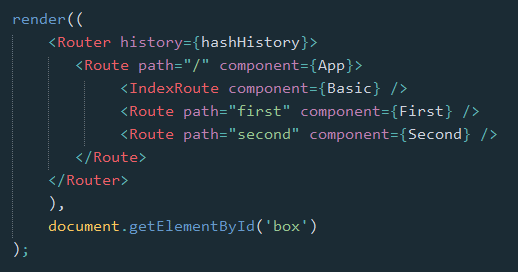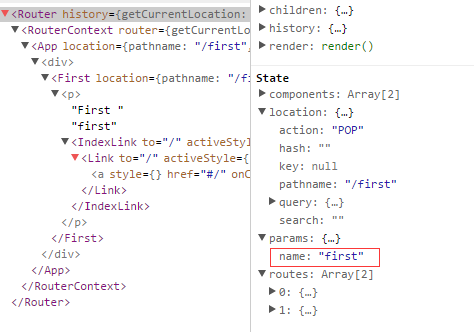React Router基础教程
React是个技术栈,单单使用React很难构建复杂的Web应用程序,很多情况下我们需要引入其他相关的技术
React Router是React的路由库,保持相关页面部件与URL间的同步
下面就来简单介绍其基础使用,更全面的可参考 指南
1. 它看起来像是这样
在页面文件中

在外部脚本文件中


2. 库的引入
React Router库的引入,有两种方式
2.1 浏览器直接引入
可以引用 这里 的浏览器版本,或者下载之后引入
然后就可以直接使用 ReactRouter 这个对象了,我们可能会使用到其中的几个属性
- let {Router, Route, IndexRoute, Redirect, IndexRedirect, Link, IndexLink, hashHistory, browserHistory} = ReactRouter;
2.2 npm 安装,通过构建工具编译引入
- npm install --save react-router
安装好路由库之后,在脚本文件中引入相关属性
- import {Router, Route, IndexRoute, Redirect, IndexRedirect, Link, IndexLink, hashHistory, browserHistory} from 'react-router';
因浏览器目前还不能支持import与export命令,且babel工具不会将require命令编译,所以我们还得需要如Webpack等构建工具编译引入
库引入之后,在ReactDOM的render方法中,就可以使用相关的组件了
3. 路由简单使用
最基本的,通过URL判断进入哪个页面(组件部件)

- class First extends Component {
- constructor(props) {
- super(props);
- }
- render() {
- return <p>First</p>
- }
- }
- class Second extends Component {
- constructor(props) {
- super(props);
- }
- render() {
- return <p>Second</p>
- }
- }
- class App extends Component {
- constructor(props) {
- super(props);
- }
- render() {
- return <div></div>
- }
- }
- render((
- <Router history={hashHistory}>
- <Route path="/" component={App} />
- <Route path="first" component={First} />
- <Route path="second" component={Second} />
- </Router>
- ),
- document.getElementById('box')
- );
首先,Router是一个容器,history属性定义了是用何种方式处理页面的URL
有三种:
- browserHistory:通过URL的变化改变路由,是推荐的一种方式,但是需要在服务器端需要做一些配置(窝目前还不知怎么配)
- hashHistory:通过#/ ,其实就像是单页面应用中常见的hashbang方式,example.com/#/path/path.. (使用简单,这里暂且就用这种方式)
- createMemoryHistory:Memory history 并不会从地址栏中操作或是读取,它能够帮助我们完成服务器端的渲染,我们得手动创建history对象
然后,在容器中使用Route组件定义各个路由,通过path指定路径(可以看到,是不区分大小写的),通过component指定该路径使用的组件
也可以直接在Router容器上直接用routes属性定义各个路由,如
- let routes =
- <div>
- <Route path="/" component={App} />
- <Route path="first" component={First} />
- <Route path="second" component={Second} />
- </div>;
- render(<Router routes={routes} history={hashHistory}></Router>, document.getElementById('box'));
需要注意的是{routes}中只能有一个父级,所以这里加了<div>标签
另外,路由Route也可以嵌套,在上面的例子中,嵌套起来可能更符合实际情况
需要注意的是,这里的App在父级,为了获取子级的First与Second组件,需要在App组件中添加 this.props.children 获取
- class App extends Component {
- constructor(props) {
- super(props);
- }
- render() {
- return <div>{this.props.children}</div>
- }
- }
- render((
- <Router history={hashHistory}>
- <Route path="/" component={App}>
- <Route path="first" component={First} />
- <Route path="second" component={Second} />
- </Route>
- </Router>
- ),
- document.getElementById('box')
- );
同样的,可以直接在Router中用routes属性定义路由
- let routes =
- <Route path="/" component={App}>
- <Route path="first" component={First} />
- <Route path="second" component={Second} />
- </Route>;
- render(<Router routes={routes} history={hashHistory}></Router>, document.getElementById('box'));
4. 路由的其他组件
除了基本的Route之外,IndexRoute、Redirect、IndexRedirect、Link、IndexLink等,顾名思义
- IndexRoute: 在主页面会用到,如上个例子中,在路径"/"下我们看到的是空白页面,可以添加默认的页面组件用于导航
- Link: 可以认为它是<a>标签在React中的实现,使用to属性定义路径,还可以通过activeClass或activeStyle定义active的样式
- IndexLink: 类似Link,推荐用来定义指向主页面的链接,当然也可以随意定义

- class First extends Component {
- constructor(props) {
- super(props);
- }
- render() {
- return (
- <p>First
- <IndexLink to="/" activeStyle={{color: 'red'}}>Basic</IndexLink>
- </p>
- )
- }
- }
- class Second extends Component {
- constructor(props) {
- super(props);
- }
- render() {
- return <p>Second</p>
- }
- }
- class Basic extends Component {
- constructor(props) {
- super(props);
- }
- render() {
- return (
- <ul role="nav">
- <li><IndexLink to="/" activeStyle={{color: 'red'}}>Basic</IndexLink></li>
- <li><Link to="/first" activeStyle={{color: 'red'}}>First</Link></li>
- <li><Link to="/Second" activeClass="active">Second</Link></li>
- </ul>
- )
- }
- }
- class App extends Component {
- constructor(props) {
- super(props);
- }
- render() {
- return <div>
- {this.props.children}
- </div>
- }
- }
- render((
- <Router history={hashHistory}>
- <Route path="/" component={App}>
- <IndexRoute component={Basic} />
- <Route path="first" component={First} />
- <Route path="second" component={Second} />
- </Route>
- </Router>
- ),
- document.getElementById('box')
- );
- Redirect: 从from路径重定向到to路径
- IndexRedirect: 在主页面,直接重定向到to路径

- render((
- <Router history={hashHistory}>
- <Route path="/" component={App}>
- <IndexRoute component={Basic} />
- <IndexRedirect to="first" />
- <Redirect from="second" to="first" />
- <Route path="first" component={First} />
- <Route path="second" component={Second} />
- </Route>
- </Router>
- ),
- document.getElementById('box')
- );
5. 路由的path规则
path定义的路由的路径,在hashHistory中,它的主页路径是#/
自定义Route路由通过与父Route的path进行合并,在与主页路径合并,得到最终的路径
- :paramName 匹配 URL 的一个部分,直到遇到下一个/、?、#
- () 表示URL的这个部分是可选的
- * 匹配任意字符(非贪婪模式),直到模式里面的下一个字符为止
- ** 匹配任意字符(贪婪模式),直到下一个/、?、#为止
- <Route path="/hello/:name"> // 匹配 /hello/michael 和 /hello/ryan
- <Route path="/hello(/:name)"> // 匹配 /hello, /hello/michael, 和 /hello/ryan
- <Route path="/files/*.*"> // 匹配 /files/hello.jpg 和 /files/hello.html
- <Route path="/**/*.jpg"> // 匹配 /files/hello.jpg 和 /files/path/to/file.jpg
而:name可以通过 this.props.params 中取到
- class First extends Component {
- constructor(props) {
- super(props);
- }
- render() {
- return (
- <p>First {this.props.params.name}
- <IndexLink to="/" activeStyle={{color: 'red'}}>Basic</IndexLink>
- </p>
- )
- }
- }
- .
- .
- <Route path="/:name" component={First} />

通过React Dev Tool也可以看到组件的相关数据

6. 路由的onEnter、onLeave钩子
在路由的跳转中,我们可能需要在进入页面或离开页面的时候做一些特殊操作,Route 通过 onEnter 与 onLeave 定义了这两个行为

- <Route path="first" component={First} onEnter={(nextState, replace) => {
- console.log(nextState);
- alert('onEnter');
- // replace('second');
- }} onLeave={() => {
- alert('onLeave');
- }}/>
如上,带两个参数,通过 replace 可以更新路径,把注释去掉后,进入"/first"时立马跳转值"/second",这在检测登录时应该比较有用

更多的使用参见 指南
React Router基础教程的更多相关文章
- [转] React Router 使用教程
PS:react-route就是一个决定生成什么父子关系的组件,一般和layout结合起来,保证layout不行,内部的子html进行跳转 你会发现,它不是一个库,也不是一个框架,而是一个庞大的体系. ...
- React Router基础使用
React是个技术栈,单单使用React很难构建复杂的Web应用程序,很多情况下我们需要引入其他相关的技术 React Router是React的路由库,保持相关页面部件与URL间的同步 下面就来简单 ...
- React Router 使用教程
一.基本用法 React Router 安装命令如下. $ npm install -S react-router 使用时,路由器Router就是React的一个组件. import { Router ...
- React-Native基础教程
React-Native牛刀小试仿京东砍啊砍砍到你手软 React-Native基础教程 *React-Native基础篇作者git *React-Native官方文档 *Demo 几个月前faceb ...
- React Router教程
React Router教程 React项目的可用的路由库是React-Router,当然这也是官方支持的.它也分为: react-router 核心组件 react-router-dom 应用于浏览 ...
- React Native基础&入门教程:初步使用Flexbox布局
在上篇中,笔者分享了部分安装并调试React Native应用过程里的一点经验,如果还没有看过的同学请点击<React Native基础&入门教程:调试React Native应用的一小 ...
- React实例入门教程(1)基础API,JSX语法--hello world
前 言 毫无疑问,react是目前最最热门的框架(没有之一),了解并学习使用React,可以说是现在每个前端工程师都需要的. 在前端领域,一个框架为何会如此之火爆,无外乎两个原因:性能优秀,开发 ...
- 【原创】React实例入门教程(1)基础API,JSX语法--hello world
前 言 毫无疑问,react是目前最最热门的框架(没有之一),了解并学习使用React,可以说是现在每个前端工程师都需要的. 在前端领域,一个框架为何会如此之火爆,无外乎两个原因:性能优秀,开发效率 ...
- React Router学习
React Router教程 本教程引用马伦老师的的教程 React项目的可用的路由库是React-Router,当然这也是官方支持的.它也分为: react-router 核心组件 react-ro ...
随机推荐
- excel查找某一列的值在、不在另一列中
统计中遇到找出一列的值不在另一列的需求: 找出A列中不在B列的值 方法如下: 使用countif函数 比如找出A列中不在B列的值: 在C1中输入 COUNTIF(B:B,A1) 下拉单元格,在首行添加 ...
- Dnsmasq安装与配置-搭建本地DNS服务器
默认的情况下,我们平时上网用的本地DNS服务器都是使用电信或者联通的,但是这样也导致了不少的问题,首当其冲的就是上网时经常莫名地弹出广告,或者莫名的流量被消耗掉导致网速变慢.其次是部分网站域名不能正常 ...
- 关于CentOS下 yum包下载下的rpm包放置路径
在CentOS下用yum安装,回发现在/var/cache/yum/下的base.extrs和updates下的packages下都没有发现下载的RPM 原来在/etc/yum.conf下没有设置下载 ...
- 在.net中使用ETW事件的方法
直到.net4.5,才有了比较便利的操作ETW的方法. 本文介绍的方法主要来源于Microsoft.Diagnostics.Tracing.TraceEvent官方资料库. 准备 (1)需要用到类:M ...
- gcc 6.0编译opencv出错
在编译opencv3.2时候,出现下面错误: cmake -DCMAKE_BUILD_TYPE=RELEASE -DCMAKE_INSTALL_PREFIX=/usr/local -DBUILD_NE ...
- 动态生成html元素并为元素追加属性
动态生成HTML元素的方法有三种: 第一种:document.createElement()创建元素,再用appendChild( )方法将元素添加到指定节点 <!DOCTYPE html> ...
- 阿里云ECS 介绍
1.阿里云产品概述 1 2.阿里云基础架构介绍 2 3. ECS产品概念和功能 6 4. ECS运维管理和API 12 1.阿里云产品概述 2.阿里云基础架构介绍 ECS 主要有五个主要的组成部分 作 ...
- InfluxDB Java入门
添加依赖 <dependency> <groupId>org.influxdb</groupId> <artifactId>influxdb-java& ...
- 【重要通知】本人所有技术文章转移至https://zzqcn.github.io
本人所有技术文章转移至 https://zzqcn.github.io
- sublime text3: markdown 安装及常用语法简介
自己上传到 github 上的 README.rdm 文件内容显示没有“美化”,所有内容都挤在一块儿了,很不舒服. 原因是:github 的文档 README.rdm 文件使用 markdown 编辑 ...
